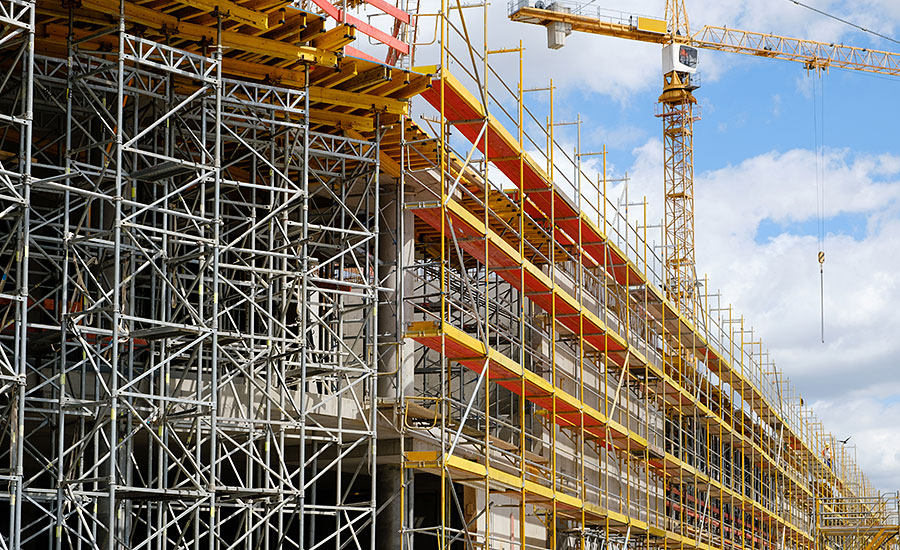The Benefits of Scaffolding for Security and Effectiveness in Building Projects
Scaffolding is a vital component in the realm of building, significantly contributing to both safety and functional effectiveness. The influence of scaffolding expands beyond standard security actions; its strategic application can change job timelines and outcomes (Scaffolding).
Enhanced Worker Safety And Security

Boosted employee safety is an extremely important problem in the construction industry, where the dangers linked with falls and crashes can have alarming repercussions. Reliable scaffolding systems play a crucial duty in mitigating these hazards by providing steady platforms for employees at raised heights. By making sure that scaffolding is correctly put up and kept, building firms can substantially lower the probability of drops, which are among the leading reasons for work environment injuries and deaths.
Moreover, scaffolding boosts safety through its layout functions. Guardrails, toe boards, and non-slip surface areas contribute to a safe and secure working setting, reducing the risk of crashes. Additionally, scaffolding permits workers to gain access to hard-to-reach areas without the demand for makeshift solutions, which can compromise safety requirements.
Training workers on the appropriate use scaffolding is equally important. Making certain that personnel are experienced about lots abilities, assembly procedures, and security protocols even more boosts the performance of scaffolding in preventing mishaps. In verdict, incorporating durable scaffolding systems within construction tasks not just boosts worker safety but also advertises a culture of safety that benefits the entire labor force while boosting general productivity.
Improved Access and Wheelchair

Moreover, scaffolding enables the practical transportation of materials and tools, decreasing downtime connected with moving tools. Workers can successfully access different locations of a project, which is especially vital in complicated builds where vertical and horizontal activity is regular - Scaffolding. This ease of access not just streamlines operations however additionally enables teams to react quickly to changing project demands
In addition, scaffolding can be tailored to accommodate particular website problems, enhancing flexibility in limited or irregular areas. This versatility ensures that construction activities can proceed smoothly, no matter the obstacles offered by the environment. By cultivating enhanced gain access to and wheelchair, scaffolding plays an important function in sustaining building teams and enhancing the general efficiency of building tasks.
Raised Project Performance
In building and construction, project efficiency is significantly affected by the reliable use scaffolding systems. By supplying a safe and steady platform for workers, scaffolding decreases downtime and increases the speed of construction activities. With better accessibility to elevated job areas, teams can finish tasks faster, lowering the general project timeline.
The modular nature of modern scaffolding permits fast assembly and disassembly, allowing swift changes between various stages of a task. This versatility not just enhances operations but likewise adds to better sychronisation amongst various trades, as several teams can work pop over to this web-site all at once on different sections of a structure.
Moreover, scaffolding ensures that workers are positioned properly to perform their jobs without unneeded strain or danger of injury, thereby minimizing the likelihood of crashes that can lead to pricey delays. Enhanced safety measures embedded in scaffolding systems, such as guardrails and toe boards, additional assistance reliable procedures by keeping employee focus on the job handy instead than security worries.

Adaptability for Various Tasks
Scaffolding systems stand out for their flexibility throughout a vast array of building tasks, efficient in conference certain site demands and jobs. Their modular layout permits for quick changes to accommodate numerous structure types, from household to business structures, guaranteeing that workers have safe gain access to at various elevations and angles.
These systems can be customized for varied applications, such as frontage work, indoor renovations, or sturdy commercial projects. For example, light-weight aluminum scaffolds are excellent for interior job, while durable steel frameworks provide the required support for massive building. The convenience of scaffolding prolongs to its ability to be configured for both irreversible and momentary frameworks, enabling service providers to efficiently intend and perform their tasks.
Additionally, scaffolding can be employed in challenging settings, consisting of city settings where area is minimal or on irregular terrain where traditional accessibility services are not practical. This versatility minimizes the demand for several access options, decreasing prices and job timelines. By accommodating a variety of problems and tasks, scaffolding improves the total performance and effectiveness of building initiatives, proving to be an essential possession in the structure market.
Conformity With Safety Specifications
Just how can construction projects make certain the safety and security of employees while preserving efficiency? Governing structures, such as OSHA in the United States, offer guidelines that control the use of scaffolding, ensuring that it fulfills rigorous security criteria.
Appropriate scaffolding layout and installment play an essential duty in conformity. Educating workers on safe scaffold use and the significance of compliance with safety standards even more enhances a society of safety and security on-site.
In addition, paperwork and record-keeping pertaining to safety inspections and employee training are crucial. These methods not only show conformity but also offer accountability and openness. Eventually, by focusing on adherence to safety and security standards, building and construction projects can cultivate a much safer job setting, thereby boosting productivity and efficiency without Recommended Site endangering worker security.
Verdict
In conclusion, scaffolding functions as a vital part in structure tasks, dramatically enhancing safety and performance. Its layout features, including guardrails and non-slip surfaces, scaffolding safety pdf add to a safer working setting while assisting in improved access and mobility for employees. The modular nature of scaffolding promotes fast assembly, thus boosting overall task efficiency. Furthermore, adherence to safety and security standards highlights the relevance of scaffolding in achieving effective project outcomes, making it vital in the construction market.
Scaffolding is an essential part in the world of building, significantly adding to both safety and security and operational performance. The influence of scaffolding extends past standard security steps; its tactical application can change project timelines and outcomes. In conclusion, including durable scaffolding systems within building and construction jobs not just enhances worker security however also advertises a society of security that benefits the whole workforce while enhancing total productivity.
In final thought, scaffolding serves as an important element in structure projects, significantly boosting security and efficiency. Adherence to safety and security standards highlights the importance of scaffolding in attaining effective project end results, making it indispensable in the construction sector.